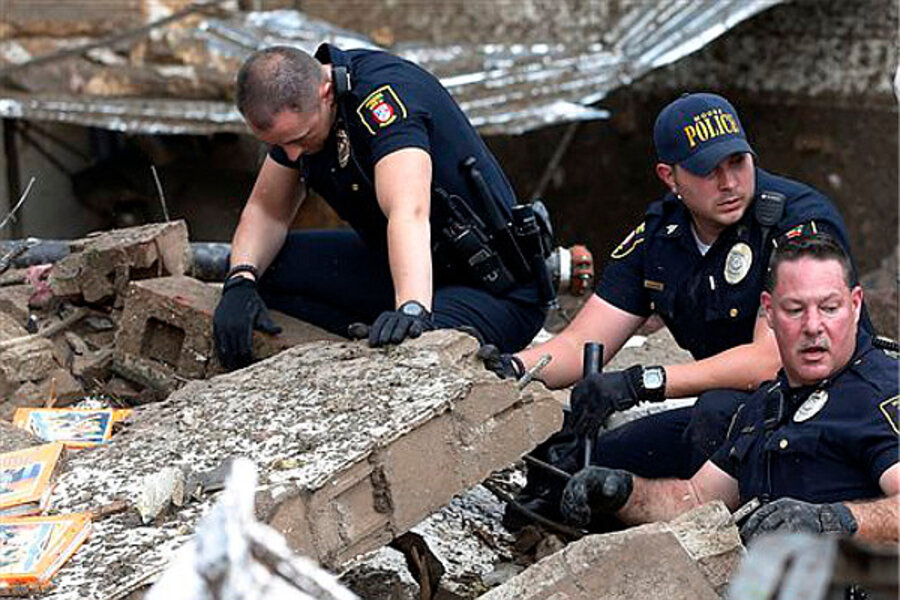Oklahoma tornado hits grade school: Search continues for survivors
Loading...
| MOORE, Okla.
A monstrous tornado at least a half-mile wide roared through the Oklahoma City suburbs Monday, flattening entire neighborhoods and destroying a Moore, Oklahoma elementary school with a direct blow as children and teachers huddled against winds up to 200 mph. At least 51 people were killed, and officials said the death toll was expected to rise.
The storm laid waste to scores of buildings in Moore, a community of 41,000 people south of the city. Block after block lay in ruins. Homes were crushed into piles of broken wood. Cars and trucks were left crumpled on the roadside.
The National Weather Service issued an initial finding that the tornado was an EF-4 on the enhanced Fujita scale, the second most-powerful type of twister.
More than 120 people were being treated at hospitals, including about 70 children.
Rescuers launched a desperate rescue effort at the school, pulling children from heaps of debris and carrying them to a triage center.
Oklahoma Gov. Mary Fallin deployed 80 National Guard members to assist with search-and-rescue operations and activated extra highway patrol officers.
Fallin also spoke with President Barack Obama, who offered the nation's help and gave Fallin a direct line to his office.
Many land lines to stricken areas were down and cellphone traffic was congested. The storm was so massive that it will take time to establish communications between rescuers and state officials, the governor said.
In video of the storm, the dark funnel cloud could be seen marching slowly across the green landscape. As it churned through the community, the twister scattered shards of wood, pieces of insulation, awnings, shingles and glass all over the streets.
Volunteers and first responders raced to search the debris for survivors.
At Plaza Towers Elementary School, the storm tore off the roof, knocked down walls and turned the playground into a mass of twisted plastic and metal.
Children from the school were among the dead, but several students were pulled alive from the rubble. Rescue workers passed the survivors down a human chain to the triage center in the parking lot.
James Rushing, who lives across the street from the school, heard reports of the approaching tornado and ran to the school, where his 5-year-old foster son, Aiden, attends classes. Rushing believed he would be safer there.
"About two minutes after I got there, the school started coming apart," he said.
The students were placed in the restroom.
Douglas Sherman drove two blocks from his home to help rescue survivors.
"Just having those kids trapped in that school, that really turns the table on a lot of things," he said.
Tiffany Thronesberry said she got an alarming call from her mother, Barbara Jarrell, after the tornado.
"I got a phone call from her screaming, 'Help! Help! I can't breathe. My house is on top of me!'" Thronesberry said.
Thronesberry hurried to her mother's house, where first responders had already pulled her out. Her mother was hospitalized for treatment for cuts and bruises.
Search and rescue efforts were to continue throughout the night.
Oklahoma City Police Capt. Dexter Nelson said downed power lines and open gas lines posed a risk in the aftermath of the system.
Monday's powerful tornado loosely followed the path of a killer twister that slammed the region in May 1999.
The weather service estimated that the storm that Monday's tornado was at least a half-mile wide. The 1999 storm had winds clocked at 300 mph.
Kelsey Angle, a weather service meteorologist in Kansas City, Mo., said it's unusual for two such powerful tornadoes to track roughly the same path.
It was the fourth tornado to hit Moore since 1998. A twister also struck in 2003.
Monday's devastation in Oklahoma came almost exactly two years after an enormous twister ripped through the city of Joplin, Mo., killing 158 people and injuring hundreds more.
That May 22, 2011, tornado was the deadliest in the United States since modern tornado record keeping began in 1950, according to the National Oceanic and Atmospheric Administration. Before Joplin, the deadliest modern tornado was June 1953 in Flint, Mich., when 116 people died.







